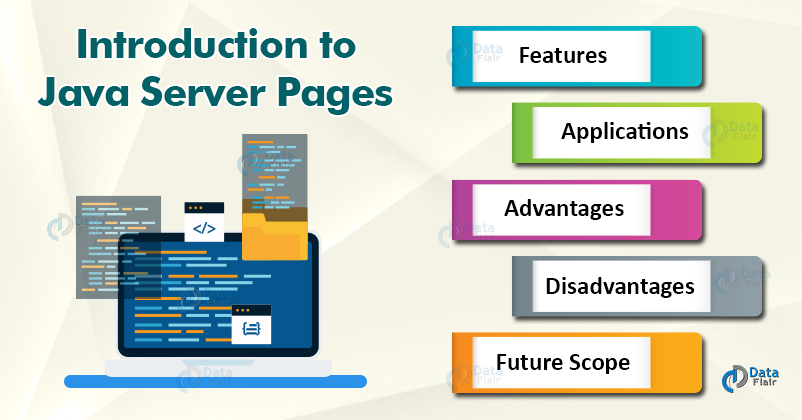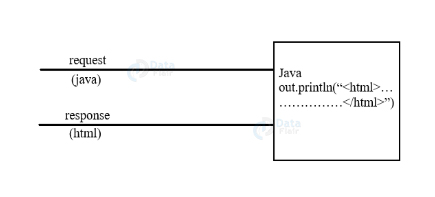JSP Tutorial for Beginners – Introduction to JSP
FREE Online Courses: Elevate Skills, Zero Cost. Enroll Now!
Welcome to DataFlair JSP Tutorial series. This article discusses Java Server Pages, which is an extension of Servlet technology. This article casts light on the features and needs of Java Server Pages. It also discusses the pros and cons of JSP. So without wasting time, let’s start!!!
Introduction to JSP
Firstly in this JSP Tutorial, we will learn what is JSP.
JSP stands for Java Server Pages. It was the first attempt to embed Java into full-fledged web applications. It is a server-side technology to create web applications. JSP is useful to create dynamic web content. It is an extension of servlet technology. Using this technology, platform-independent web pages can be created. JSP, in the end, is converted into a servlet through a web container.
Furthermore in this JSP tutorial, we will discuss –
- Why JSP?
- Features of JSP
- Need of JSP
- Application of JSP
- Advantages of JSP
- Disadvantages of JSP
- Future scope of JSP
Why JSP?
Before starting off with JSP, it is must that we answer the fundamental question of why JSP is important. What advantages or features made it come into play.
Though JSP serves the same purpose as programming in command line interface languages, it brings a lot of advantages with it which are as below:
- JSP’s are compiled before being processed.
- JSP is an essential platform for enterprise-class applications as it is interactive(discussed in detail below) and is an important branch of Java EE applications.
- It plays a vital role from the simplest to complex applications.
- JSP effectively implements the Model-View-Controller model, which will be further discussed with the JSP architecture.
- We can use it in combination with other technologies like servlets.
Above mentioned points tell us clearly why JSP came into play. Let us discuss other peripheries in detail.
Features of Java Server Pages
Technology is evolving rapidly!
Stay updated with DataFlair on WhatsApp!!
1. JSP makes coding easier as it provides more functionality: JSP is way more functional as compared to other technologies. The ease of coding, generation of dynamic content, use of scriptlet tags, separation of logics makes it functional.
2. JSP solves the shortcomings of servlets: Servlet technology is somewhat interdependent, whereas JSP technology is free from dependencies, thus fulfilling shortcomings of servlet technology.
3. Extension of servlet technology: JSP is an extension of servlet technology but way effective and efficient. It deploys all features and advantages of servlet technology as well as its own additional features.
4. It effectively separates designing and development: Developer’s do development in java language whereas page authors design Page using HTML or XML
5. In JSP the service methods are auto-generated for every request: The code for each and every request gets copied to an invoked _jspServive() method.
6. JSP provides various libraries for e.g. JSTL, custom tags etc.: The availability of libraries increases the range of usage of JSP pages.
7. JSP embeds Java into HTML, CSS, Javascript: JSP makes the coding simpler and less cumbersome than any other technology.
8. JSP doesn’t require recompilation and redeployment unlike servlets: JSP is dynamic, as well as platform-independent. Thus these features imply that recompilation and redevelopment is not required in JSP
9. JSP helps in making interactive websites: The output of a JSP page is dynamic web content that makes it interactive and engaging. The type of output content can also be made as required in JSP
10. JSP makes connection to databases efficient and easier: As the connections are efficient, it becomes easier to read and write to the database.
11. Portable Technology: It is a server-side scripting language i.e., all computations are done on the server-side. This technology is independent of the browser as well as a server that makes it platform-independent and is thus portable
12. Flexible technology: The usage of customized tags makes the technology powerful and flexible.
13. Fast to develop: As the complexities are reduced, JSP is easy and fast to design and develop.
Need for JSP
1. Static content is generated by Java from inside the servlet. Designing is also difficult in servlets. The use of JSP makes designing easier as well as generates dynamic content that makes websites engaging. For e.g.
In servlets
In JSP
2. For each and every request in the servlet, you have to write a new service method. There can be no requests; thus writing new service methods each time can be tiresome. Unlike servlets, in JSP the service methods are auto-generated using scriptlet tag.
3. When a modification is made in static content, then the servlet needs to recompile and redeploy it as it is in java code. Whereas in JSP, there is no need for recompilation and redeployment. For e.g., If in servlet you need heading to be bigger, you change out.println(“<h1>”) to out.println(“<h2>”) then you need to recompi;e the whole code, unlike JSP.
Application of JSP
Let’s see the comparison of JSP with other technologies that make it advantageous over later.
1. JSP vs. Basic HTML
JSP can produce dynamic content, whereas HTML cannot produce dynamic content.
2. JSP vs. ASP
JSP is Java Server Pages, whereas ASP is Active Server Pages. Both of the technologies are server-side programming languages. ASP’s are interpreted at fly time. On the other hand, JSP takes time to load as they need to be compiled at run time. But JSP works faster than ASP once loaded. JSP technology is available for free, but ASP costs money.
3. JSP vs. JavaScript
JavaSript can’t interact with web browsers to perform computations like database access though it can generate dynamic HTML content. JSP’s capability to interact makes it way more applicable over JavaScript.
4. JSP vs. SSI
SSI stands for Server-side Includes that can perform basic operations but lacks to perform real complex programs like taking data from forms and maintaining database connections.
5. JSP vs. Pure Servlets
As discussed earlier, it is more convenient to write Java and HTML codes separately rather than having lots of println statements in Java code. This makes the modification of the code easier. Thus JSP proves its application over pure servlets.
These comparisons make it easier to understand why JSP is more applicable over other technologies.
Advantages of JSP
1. JSP is easy to code and maintain.
2. JSP has high performance and scalability.
3. JSP is built on Java technology thus, it is platform-independent.
4. JSP allows the distribution of the functionality to a wide range of page authors.
5. Use of implicit objects reduces the length of code, and thus, it is easy to maintain.
6. Exception handling is done effectively in JSP.
7. Page authors can easily update presentation logic using HTML coding and don’t need to worry about Java Programming.
8. Visual logic and business logic separation makes it easy to handle.
9. Developers can offer custom tags that can be used by page authors in XML language.
10. Developers’ efforts are minimal as they need to implement business logic while page authors deal with user interface logic.
Disadvantages of JSP
1. It is difficult to debug for errors as .jsp page is first converted to.java file. An error in the 3rd line of JSP might appear at the 20th line of Java code.
2. First time access requires compilation at the run time thus leads to wastage of time
3. Its output is HTML. HTML lacks certain features making it a disadvantage for JSP.
4. It becomes difficult to choose the right servlet engine due to the lack of benchmark testing and stability of engine.
Future scope of JSP
JSP and servlets still have their place as many companies out there are using it for their web UIs. Though no new significant features have been added to it as well as companies are shifting to JSF (Java Server Faces), it is not the end for JSP. Its reusability, maintainability, and easiness have kept it in use. The current trend is however, more towards JS and JSON for new projects. Even though JSP is far from dead right now.
Conclusion
Finally we completed the JSP Tutorial article. JSP separates presentation logic (client’s end) and business logic(server end). Web designers can design and update JSP creating presentation layers. On the other hand, Java developers can write server-side complex computational code. Thus both layers can easily interact over HTTP requests.
Your 15 seconds will encourage us to work even harder
Please share your happy experience on Google




